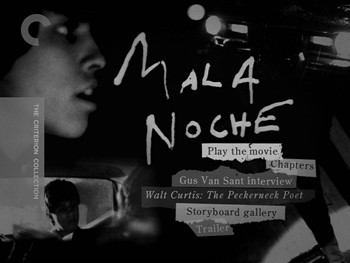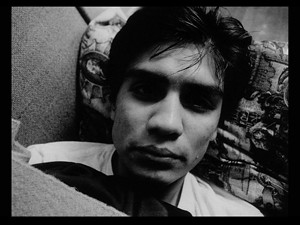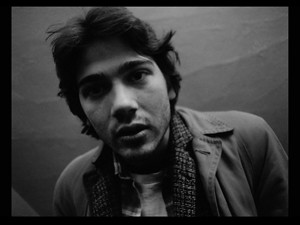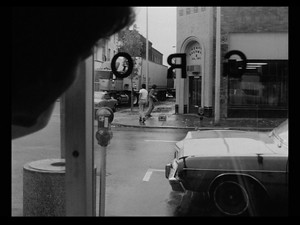
Living in Portland, Oregon, everyone has a Gus Van Sant story. Mine is pretty mundane. I saw him once at a New Year's Day hangover party. He was standing off to the side with some friends, quiet. I never spoke to him or got introduced to him, a fact my host lamented when it came up later. No big deal. This is Portland. I'm sure I'll have the chance again.
Van Sant has made his home in Portland for many years, and quite a few of his movies are not just love letters to the city, but snapshots of periods of time, a preservation of the streets we all walk. Just as much as we have Gus Van Sant stories, we can point out what was once the pharmacy robbed in Drugstore Cowboy
Mala Noche, Van Sant's first movie, started this trend. Dating back to 1985 (though first shown in 1987), it's a little harder to spot familiar landmarks since a lot of them are now gone, but I'm pretty sure I used to live a couple of blocks from the car dealership that Walt (Tim Streeter) first propositions Johnny (Doug Cooeyate) outside of. If I'm right, they sell Jaguars now; if I'm wrong, we'll still say I'm right and categorize it as the personal appropriation of local lore.
In addition to being a snapshot of mid-'80s Portland, Mala Noche is also an important freeze frame of an intersection of queer and independent cinema. Post-Jim Jarmusch, pre-Todd Haynes, it's the kind of landmark that changes what is possible, that gives new filmmakers permission to go further out on a limb. In style, it owes a little bit to Jarmusch (specifically Stranger Than Paradise), but Haynes probably took a little bit from Mala Noche when it came time to make Poison. The lineage is complete.
Up until now, though, Mala Noche (which translates as "Bad Night") has not been available on home video, much less DVD. A video store I used to work at had a couple of ancient VHS copies that they believed Van Sant made himself, but I never stepped down to watch it in that format, because surely such an important and distinctive film was going to get put out on DVD by somebody. Thanks to the folks at the Criterion Collection, someone now has.
So, how does the Mala Noche - Criterion Collection hold up? Pretty good as it turns out. Based on an autobiographical story by maverick writer Walt Curtis, the film follows the struggling author on his quest to connect with Johnny, the pretty illegal alien who rode a train to Puddletown from Mexico and who is far cagier than his silence would suggest. Johnny keeps Walt at arm's length, even when money is offered, sticking around for the things he can get from the desperate store clerk and playing at street games that skirt the edges of danger. The closest that Walt ever gets to sleeping with Johnny is Robert, a.k.a. Pepper (Ray Monge), the even quieter sidekick. Over the course of a couple of weeks, the boys move in and out of Walt's life, twist him in knots, and also get more trouble than they bargained for.


Van Sant and cameraman John Campbell, who also lensed Idaho and Even Cowgirls Get the Blues
Mala Noche isn't a perfect film. The Walt character is a little hard to like, always on the make, though eventually it stops feeling like he's taking advantage of the young boys and it's clear they are really controlling him. That tightrope that Van Sant walks in trying to show urban ennui also ends up making the film seem choppy. The narrative's internal sense of time is confused, and some of the heavier scenes don't come across with the full weight they demand, resulting in Mala Noche ultimately feeling a tad inconsequential.
Still, Van Sant's visual style is already emerging, and his freewheeling tone is probably at its freshest thanks to the first-time director's naïveté. As with so many watershed moments in art, it's what follows the barrier being broken down that is usually the more enduring material, but that doesn't devalue the pioneers. If nothing else, Mala Noche captures the feeling of a particular time out on the fringes, both for queer males and for filmmakers trying to smash the system. It's got that fire of youthful rebellion, and regardless of how far from Van Sant's starting point we travel, that first spark will always be there.

Originally written October 9, 2007. For technical specs and special features, read the full article at DVD Talk.

1 comment:
Some inaccuracies- Gus and I went to see Stranger than Paradise when it first released and Mala Noche was “in the can.” I turned to Gus shortly after the film started and said “Everyone is gonna think we ripped this off.” Gus just shrugged in that very matter fact way he has. I can attest Mala Noche was done shooting by the time Stranger than Paradise released.
Tim Streeter
Post a Comment